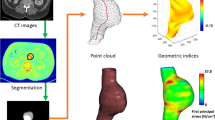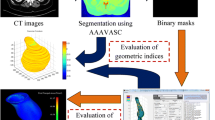Abstract
The spatial distributions of both wall stress and wall strength are required to accurately evaluate the rupture potential for an individual abdominal aortic aneurysm (AAA). The purpose of this study was to develop a statistical model to non-invasively estimate the distribution of AAA wall strength. Seven parameters–namely age, gender, family history of AAA, smoking status, AAA size, local diameter, and local intraluminal thrombus (ILT) thickness–were either directly measured or recorded from the patients hospital chart. Wall strength values corresponding to these predictor variables were calculated from the tensile testing of surgically procured AAA wall specimens. Backwards–stepwise regression techniques were used to identify and eliminate insignificant predictors for wall strength. Linear mixed-effects modeling was used to derive a final statistical model for AAA wall strength, from which 95% confidence intervals on the model parameters were formed. The final statistical model for AAA wall strength consisted of the following variables: sex, family history, ILT thickness, and normalized transverse diameter. Demonstrative application of the model revealed a unique, complex wall strength distribution, with strength values ranging from 56 N/cm2 to 133 N/cm2. A four-parameter statistical model for the noninvasive estimation of patient-specific AAA wall strength distribution has been successfully developed. The currently developed model represents a first attempt towards the noninvasive assessment of AAA wall strength. Coupling this model with our stress analysis technique may provide a more accurate means to estimate patient-specific rupture potential of AAA.




Similar content being viewed by others
REFERENCES
Department of Commerce US Current population reports: U.S. Bureau of the census statistical abstract of the United States.: Washington, 1994.
Aiken, L. S., and S. G. West. Multiple Regression: Testing and Interpreting Interactions. Newbury Park, CA: Sage Publications, 1991.
Alcorn, H. G., S. K. Wolfson, and K. Sutton-Tyrrell. Risk factors for abdominal aortic aneurysms in older adults enrolled in the Cardiovascular Health Study. Arterioscler. Thromb. Vasc. Biol., 16:963–970, 1996.
Bengtsson, H., and D. Bergqvist. Ruptured abdominal aortic aneurysm: a population-based study. J. Vasc. Surg. 18:74–80, 1993.
Bengtsson, H., B. Sonesson, and D. Bergqvist. Incidence and prevalence of abdominal aortic aneurysms. estimated by necropsy studies and population screening by ultrasound. Ann. N.Y. Acad Sci. 800:1–24, 1996.
Blanchard, J. F. Epidemiology of Abdominal Aortic Aneurysms. Epidemiol. Rev. 21(2):207–221, 1999.
Brown, H., and R. Prescott. Applied Mixed Models in Medicine. Chichester, England: John Wiley & Sons, 1999.
Cohen, J., P. Cohen, S. G. West, and L. S. Aiken. Applied multiple regression/correlation analysis for the behavioral sciences. Hillsdale, NJ: Lawrence Erlbaum Associates, 2003.
Cole, C. W., G. G. Barber, and A. G. Bouchard. Abdominal aortic aneurysm: consequences of a positive family history. Can. J. Surg. 32:117–120, 1989.
Cole, C. W., G. B. Hill, W. J. Millar, A. Laupacis, and K. W. Johnston. Selective screening for abdominal aortic aneurysm. Chronic. Dis. Can. 17(2):51–55, 1996.
da Silva, E. S., A. J. Rodrigues, E. M. C. de Tolosa, C. J. Rodrigus, G. Villas Boas do Prado, and J. C. Nakamoto. Morphology and Diameter of Infrarenal Aortic Aneurysms: A Prospective Autopsy Study. Cardiovasc. Surg. 8(7):526–532, 2000.
Darling, R. C., D. C. Brewster, and G. M. LaMuaglia. Are familial abdominal aortic aneurysm different? J. Vasc. Surg. 10:39–43, 1989.
Darling, R. C., C. R. Messina, D. C. Brewster, and L. W. Ottinger. Autopsy study of unoperated abdominal aortic aneurysms. Circulation 56(2):161–164, 1977.
Di Martino, E., A. Bohra, J. P. Vande Geest, N. Y. Gupta, M. S. Makaroun, and D. A. Vorp. Biomechanical properties of ruptured versus electively repaired abdominal aortic aneurysm wall tissue. in 2004 Fall meeting of the Biomedical Engineering Society. Philadelphia, PA, 2004.
Di Martino, E., S. Mantero, F. Inzoli, G. Melissano, D. Astore, R. Chiesa, and R. Fumero. Biomechanics of abdominal aortic aneurysm in the presence of endoluminal thrombus: experimental characterisation and structural static computational analysis. Eur. J. Vasc. Endovasc. Surg. 15(4):290–299, 1998.
Di Martino, E. S., and D. A. Vorp. Effect of variation in intraluminal thrombus constitutive properties on abdominal aortic aneurysm wall stress. Ann. Biomed. Eng. 31(7):804–809, 2003.
Dobrin, P. Pathophysiology and pathogenesis of aortic aneurysms. Current concepts. Surg. Clin. North Am. 69:687–703, 1989.
Drapper, N., and H. Smith. Applied Regression Analysis. 2nd ed. New York: Wiely, 417, 1981.
Elger, D. F., D. M. Blackketter, R. S. Budwig, and K. H. Johansen. The influence of shape on the stresses in model abdominal aortic aneurysms. Neurourol. Urodyn. 118:326–332, 1996.
Fillinger, M. F., S. P. Marra, M. L. Raghavan, and F. E. Kennedy. Prediction of rupture risk in abdominal aortic aneurysm during observation: wall stress versus diameter. J. Vasc. Surg. 37(4):724–732, 2003.
Fillinger, M. F., M. L. Raghavan, S. P. Marra, J. L. Cronenwett, and F. E. Kennedy. in vivo analysis of mechanical wall stress and abdominal aortic aneurysm rupture risk. J. Vasc. Surg. 36(3):589–597, 2002.
Fitzgerald, P., D. Ramsbottom, and P. Burke. Abdominal aortic aneurysm in the Irish population: a familial screening study. Br. J. Surg. 32:117–120, 1989.
Jacob, M. P., B.-C. C., V. Fontaine, Y. Benazzoug, L. Feldman, and J. B. Michel. Extracellular matrix remodeling in the vascular wall. Pathol. Biol. 49(4):326–332, 2001.
Johansen, K., and T. Koepsell. Familial tendency for abdominal aortic aneurysms. JAMA 256:1934–1936, 1986.
Lillienfeld, D. E., D. Gunderson, J. M. Sprafka, and C. Vargas. Epidemiology of aortic aneurysms. I. Mortality trends in the United State, 1951 to 1981. Ateriosclerosis 7:637–643, 1987.
Limet, R. N., N. Sakalishasan, and A. Albert. Determination of the expansion rate and incidence of rupture of abdominal aortic aneurysm. J. Vasc. Surg. 14:540–548, 1991.
Menashi, S., R. M. Gennhalgh, and J. T. Powell. Collagen in abdominal aortic aneurysm: Typying, content and degradation. J. Vasc. Surg. 6:578–582, 1987.
Mower, W. R., L. J. Baraff, and J. Sneyd. Stress distributions in vascular aneurysms: factors affecting risk of aneurysm rupture. J. Surg. Res. 55:155–161, 1993.
Mower, W. R., W. J. Quinones, and S. S. Gambhir. Effect of intraluminal thrombus on abdominal aortic aneurysm wall stress. J. Vas. Surg. 26:602–608, 1997.
Pinheiro, J. C. and D. M. Bates. Mixed-Effects Models in S and S-PLUS. New York: Springer-Verlag, 2000.
Powell, J. T., P. Worrell, S. T. R. MacSweeney, P. J. Franks, and R. M. Greenhalgh. Smoking as a risk factor for abdominal aortic aneurysm. Ann. N.Y. ACAD Sci. 800:246–248, 1996.
Raghavan, M. L., D. A. Vorp, M. P. Federle, M. S. Makaroun, and M. W. Webster. Wall stress distribution on three-dimensionally reconstructed models of human abdominal aortic aneurysm. J. Vasc. Surg. 31(4):760–769, 2000.
Raghavan, M. L., M. W. Webster, and D. A. Vorp. Ex-vivo Biomechanical Behavior of Abdominal Aortic Aneurysm: Assessment Using a New Mathematical Model. Ann. Biomed. Eng. 24:573–582, 1996.
Sacks, M. S., D. A. Vorp, M. L. Raghavan, M. P. Federle, and M. W. Webster. In-vivo 3D Surface geometry of Abdominal Aortic Aneurysm. Ann. Biomed. Eng. 27:469–479, 1999.
Sakalihasan, N., A. Heyeres, B. V. Nusgens, R. Limet, and C. M. Lapiere. Modifications of the extracellular matrix of aneurysmal abdominal aorta as a function of their size. Eur. J. Vasc. Surg. 7:633–637, 1993.
Sonesson, B., F. Hansen, H. Stale, and T. Lanne. Compliance and diameter in the human abdominal aorta-the influence of age and sex. Eur. J. Vasc. Surg. 7:690–697, 1993.
Strachan, D. P. Predictors of death from aortic aneurysm among middle-aged men; the Whitehall study. Br. J. Surg. 79:401–404, 1991.
Stringfellow, M. M., P. F. Lawrence, and R. G. Stringfellow. The influence of aorta-aneurysm geometry upon stress in the aneurysm wall. J. Surg. Res. 42:425–433, 1987.
Venkatasubramaniam, A. K., M. J. Fagan, T. Mehta, K. J. Mylankal, B. Ray, G. Kuhan, I. C. Chetter, and P. T. McCollum. A comparative study of aortic wall stress using finite element analysis for ruptured and non-ruptured abdominal aortic aneurysms. Eur. J. Vasc. Endovasc. Surg. 28(2):168–176, 2004.
Vorp, D. A., P. C. Lee, D. H. Wang, M. S. Makaroun, E. M. Nemoto, S. Ogawa, and M. W. Webster. Association of intraluminal thrombus in abdominal aortic aneurysm with local hypoxia and wall weakening. J. Vasc. Surg. 34(2):291–299, 2001.
Vorp, D. A., M. L. Raghavan, S. C. Muluk, M. S. Makaroun, D. L. Steed, and M. W. Webster. Wall strength and stiffness of aneurysmal and nonaneurysmal abdominal aorta. Ann. N.Y. Acad. Sci. (800):274–277, 1996.
Vorp, D. A., M. L. Raghavan, and M. W. Webster. Mechanical wall stress in abdominal aortic aneurysm: Influence of diameter and asymmetry. J. Vasc. Surg. 27(4):27, 1998.
Vorp, D. A., D. H. Wang, M. W. Webster, and W. J. Federspiel. Effect of intraluminal thrombus thickness and bulge diameter on the oxygen flow in abdominal aortic aneurysm. J. Biomech. Eng. 120:579–583, 1998.
Wang, D. Noninvasive biomechanical assessment of the rupture potential of abdominal aortic aneurysms, in Department of Bioengineering. Pittsburgh, PA: University of Pittsburgh, 2002.
Wang, D. H., M. S. Makaroun, M. W. Webster, and D. A. Vorp. Effect of intraluminal thrombus on wall stress in patient-specific models of abdominal aortic aneurysm. J. Vasc. Surg. 36(3):598–604, 2002.
Wang, D. H. J., S. B., M. S. Makaroun, M.W. Webster, and D. A. Vorp. Effect of Intraluminal Thrombus on Local Abdominal Aortic Aneurysm Wall Strength. Ann. Biomed. Eng. 27(Sup. 1), 1999.
Webster, M. W., P. L. St. Jean, and D. L. Steed. Abdominal aortic aneurysm: results of a family study. J. Vasc. Surg. (13):366–372, 1991.
Wilson, K. A., A. J. Lee, P. R. Hoskins, F. G. Fowkes, C. V. Ruckley, and A. W. Bradbury. The relationship between aortic wall distensibility and rupture of infrarenal abdominal aortic aneurysm. J. Vasc. Surg. 37(1):112–117, 2003.
ACKNOWLEDGMENTS
The authors acknowledge the technical contributions made to this work by Mr. Mohammed El-Kurdi. This work was supported by grants from The Pittsburgh Foundation, and the NIH (grants #RO1 HL 060670 and #R01 HL 079313), all to DAV.
Author information
Authors and Affiliations
Corresponding author
Rights and permissions
About this article
Cite this article
Vande Geest, J.P., Wang, D.H.J., Wisniewski, S.R. et al. Towards A Noninvasive Method for Determination of Patient-Specific Wall Strength Distribution in Abdominal Aortic Aneurysms. Ann Biomed Eng 34, 1098–1106 (2006). https://doi.org/10.1007/s10439-006-9132-6
Received:
Accepted:
Published:
Issue Date:
DOI: https://doi.org/10.1007/s10439-006-9132-6




